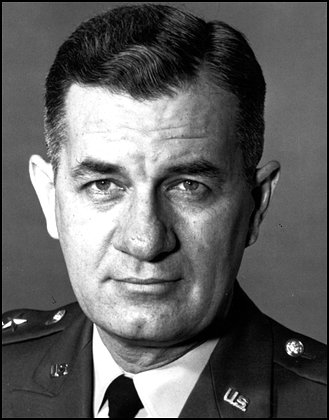Wednesday, 15 December 2004:
U.S. Army Lieutenant General John Norton Dies at 86
By Matt Schudel
Courtesy of the Washington Post
John Norton, 86, an Army Lieutenant General who, as a young officer, parachuted into Normandy on D-Day and later helped pioneer the Army’s use of helicopters in battle, died December 6, 2004, of cancer at his home in Basye, Virginia.
General Norton, who was known as Jack, spent nearly 40 years in the Army. He joined in the mid-1930s and, after two years as an enlisted man, won an appointment to the U.S. Military Academy. At West Point, the faculty named him first captain of the Class of 1941, an honor bestowed on one cadet a year for academic achievement and leadership. The future general was the cadet commander of the corps at the academy.
During World War II, General Norton was a paratrooper with the 505th Parachute Infantry Regiment of the famed 82nd Airborne Division, jumping behind German lines into the French village of St. Mere-Eglise on D-Day. A museum honoring the airborne efforts on D-Day now stands in St. Mere-Eglise.
General Norton also participated in the Battle of the Bulge and saw combat in Sicily, Italy, Belgium and Germany. In January 1946, he helped plan a victory parade in New York, leading the troops of the 82nd Airborne.
In the late 1940s, General Norton assisted Army General James M. Gavin in planning policies to coordinate airborne activities with the newly formed Air Force. From 1950 to 1953, he was executive officer to Army Secretary Frank Pace Jr. He spent the next several years in Yugoslavia, administering a federal aid program.
After receiving certification as an airplane and helicopter pilot in 1956, General Norton had a major role in shaping aviation within the Army. In 1962, he was a member of the Howze Board, directed by Lieutenant General Hamilton Howze, that devised the Army’s modern doctrine of using airpower in wartime. Among other things, it outlined the future use of helicopters in combat.
General Norton became commanding general of the Army’s 1st Cavalry Division in Vietnam in 1966, putting into practice the air cavalry recommendations he had helped frame four years before.
From 1970 to 1973, he was commanding general of the Combat Development Command at Fort Belvoir, where he oversaw the early steps of building the Black Hawk helicopter and the M1 Abrams main battle tank. In his final military post, from 1973 to 1975, Gen. Norton was deputy commander in chief of NATO’s Allied Joint Force Command in Naples.
He received four awards of the Distinguished Service Medal, the Silver Star, four awards of the Legion of Merit, two Bronze Stars, the Air Medal and the Combat Infantryman’s Badge.
General Norton was born at Fort Monroe, Virginia, and grew up in Norfolk. After his retirement from the Army, he worked with other military leaders in advising Pentagon officials and members of Congress. He also closely followed developments at West Point. He assisted in preparing three documentaries about airborne operations during World War II for the History Channel.
He is a member of the Army Aviation Hall of Fame and the Army Field Experimentation Hall of Fame. In September, he received the Doughboy Award for his contributions to combat infantry.
He lived at several military bases near Washington, as well as in Alexandria, Kensington and Basye.
His wife of 46 years, Cheyney McNabb Norton, died in 1992.
His second wife, Leslie C. Smith, whom he married in 1992, died in 2002.
Survivors include three children, retired Army Lieutenant Colonel John Norton Jr. of Berryville, Virginia, Alexandra Norton of San Miguel de Allende, Mexico, and Cheyney Edwards of Warrenton; a sister; nine grandchildren; and two great-grandchildren.
General Norton will be buried with full military honors at Arlington National Cemetery on Wednesday, 5 January 2005.
Michael Robert Patterson was born in Arlington and is the son of a former officer of the US Army. So it was no wonder that sooner or later his interests drew him to American history and especially to American military history. Many of his articles can be found on renowned portals like the New York Times, Washingtonpost or Wikipedia.
Reviewed by: Michael Howard


